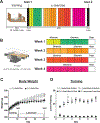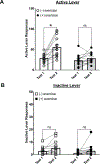Acute high-intensity interval exercise attenuates incubation of craving for foods high in fat
- PMID: 35384349
- PMCID: PMC9050900
- DOI: 10.1002/oby.23418
Acute high-intensity interval exercise attenuates incubation of craving for foods high in fat
Abstract
Objective: Food-seeking behaviors can be driven by food-associated cues, and palatable food seeking in response to food cues is a risk factor for obesity development. Cue-induced food seeking increases following a period of abstinence, a behavioral phenomenon known as "incubation of craving," which may contribute to an individual's difficulty abstaining from palatable foods. Pharmacological and environmental manipulations have been employed to try and reduce incubation of craving, albeit primarily in drug abuse paradigms. The goal of this study was to determine whether forced exercise can attenuate incubation of high-fat food craving.
Methods: Male Sprague Dawley rats learned to self-administer high-fat pellets (60%) in combination with a compound cue (light + tone). The influence of high-intensity interval exercise on the time-dependent increase in cue-induced lever responding was investigated 30 days after the first cue test.
Results: Rats exposed to exercise during abstinence did not express incubation of craving.
Conclusions: The results suggest that high-intensity exercise can prevent the establishment of incubation of craving for foods high in fat and may reduce cue-induced maladaptive food-seeking behaviors that contribute to overeating and obesity.
© 2022 The Obesity Society.
Conflict of interest statement
Figures


References
-
- World Health Organization. Obesity and overweight. 2021; Available from: https://www.who.int/news-room/fact-sheets/detail/obesity-and-overweight.
-
- Volkow ND, Wise RA, and Baler R, The dopamine motive system: implications for drug and food addiction. Nat Rev Neurosci, 2017. 18(12): p. 741–752. - PubMed
-
- Gawin FH and Kleber HD, Abstinence symptomatology and psychiatric diagnosis in cocaine abusers. Clinical observations. Arch Gen Psychiatry, 1986. 43(2): p. 107–13. - PubMed
Publication types
MeSH terms
Grants and funding
LinkOut - more resources
Full Text Sources

